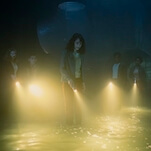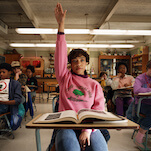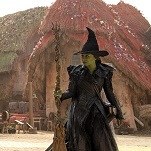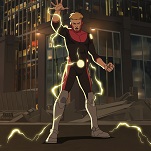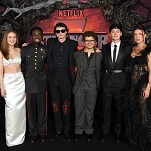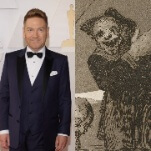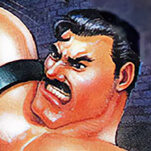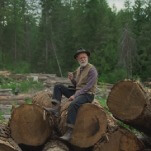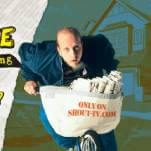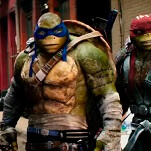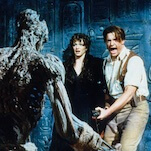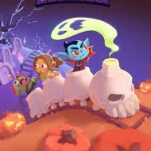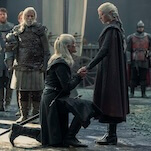Earlier this year, NBM Publishing’s “Amerotica” imprint packaged together the existing seven volumes of The Complete “Omaha” The Cat Dancer, and since I hadn’t read Omaha since the early ’90s, I requested a set, to see whether the series still seemed as groundbreaking as it once did. Cartoonist Reed Waller began writing and drawing his stories about a stripper with superior dancing skills in various underground comix anthologies in the late ’70 and early ’80s, then launched Omaha as a standalone series in 1984, with the help of writer Kate Worley. By then, the original underground comix boom had quieted, and regularly published, independent comics series for adults were fairly rare. Waller’s cute-yet-refined “funny animal” art, along with his and Worley’s elaborate, soap-y stories about Omaha and her artist boyfriend Chuck (the son of a mentally ill millionaire), marked Omaha as part of an emerging trend toward long-form, non-superhero comics. The characters were engaging, the narrative twisty, and the social commentary pointed.
And, of course, every so often the action would stop for a few pages of anthropomorphic animals fucking.
As with just about every art form, there’s been sex in comics for as long as there have been comics. (Especially if you trace sequential art back to cave walls, which could get pretty racy.) In the ’20s, the black market carried “Tijuana bibles,” offering pornographic versions of popular comic strip characters. Then in the ’60s, underground cartoonists made sexual explicitness—along with drug use and graphic violence—a major component of their taboo-busting. Anyone with any interest in serious comics from the late ’60s through the early ’90s expected some sex as a matter of course, not unlike the way that adults who went to R-rated movies in that era expected a least a little nudity. It wasn’t the reason to see the movies or read the comics, but there was an implicit understanding that sex is a part of life, and that one of the privileges of being an adult is being allowed to appreciate human sexuality.
Comics never lost its Tijuana bible side, though. Alongside Omaha and titles like Guy Colwell’s politically astute Doll—about a deformed man who commissions a realistic sex toy, which then becomes a much-desired lust-object—the adults-only section of comic-book stores featured the likes of Cherry Poptart, Larry Welz’s pornographic riff on Archie. When Fantagraphics launched its Eros Comix line (to help subsidize its low-selling literary comics), initially the company promised to mix in as much art as readers could abide, via titles like Gilbert Hernandez’s surreal Birdland and Dennis Eichhorn’s autobiographical Real Smut. But Eros quickly devolved into straight-up porn, with minimal artistry or narrative craft.
Omaha, on the other hand, became less about the sex and more about story over time—even after the book migrated to Eros. Omaha was nominated for multiple Eisners during Waller and Worley’s run, until medical woes and romantic disagreements effectively ended the series in the mid-’90s. The former partners tried to revive and complete Omaha in the early ’00s, but Worley’s death from lung cancer in 2004 proved too significant an obstacle. Still, during the series’ heyday, Omaha sensitively explored devotion and jealousy and hypocrisy, via the ever-shifting relationships of the main characters. It was no masterpiece, but it was entertaining and more fun to read that about 95 percent of what was on the shelves at the time. And it wasn’t regarded as “dirty,” really, any more than the frequently sexy Love And Rockets was. The covers to the original Omaha collections were rarely lurid; they were more like conventional romance comics. That the covers to the new NBM/Amerotica editions emphasize nudity says something about where we’re at right now as a culture when it comes to sexually explicit art. Omaha was once a literary comic with some sex; now it’s a sex comic with some literary qualities.
Not that I blame NBM for this marketing approach. It’s not like the covers to the new collections are false advertising. Omaha is full of sex, with plenty of licking and penetration and the swapping of bodily fluids. I’d even say that the sex scenes border on the gratuitous at times, as though Waller and Worley were making sure they didn’t forget what paid the bills.
Then again, the question of what’s “gratuitous” when it comes to sex in art isn’t something to take lightly. Is showing a nude body with little to no narrative justification any more gratuitous than showing a sunset, or a pretty-looking landscape? Isn’t pure aesthetic pleasure one of the primary functions of art? Matt Zoller Seitz wrote a terrific essay about this subject for Salon, addressing the persistent tongue-clucking over the copious nudity in HBO’s Game Of Thrones. “It all reminds me of a Jack Nicholson quote from the 1970s, complaining about the hypocrisy of the MPAA ratings system,” Seitz wrote. “‘Cut off a woman’s tit with a sword, they give you a PG. Kiss it, and it’s an R.’” By and large, I’m in the Seitz camp here. I appreciate some people’s concerns about exploitation and sexism, but I don’t think we should go so overboard in being sensitive to them that we make “unmotivated” appreciation of a naked body into something shameful.
Moreover, I believe art that deals honestly with sex is vital, as I wrote in a mini-essay about Prince in my “Popless” series a few years ago:
Sex education in my day and in my community was generally cobbled together from smutty jokes, late-night TV, R-rated movies, Judy Blume books, and schoolyard chatter. … Listening to Dirty Mind, or the more titillating tracks off 1999 and Purple Rain, made me feel like a gentleman of the world, sophisticated enough to appreciate the nuances and meaning of a line like, “I sincerely want to fuck the taste out of your mouth.” Discovering Prince was like stumbling across a warp zone in a videogame, and jumping ahead from “adolescent” to “adult.” … It would be a mistake to discount the liberating effect that sexually explicit material can have on those who need it, whether because they were raised in a strict religious home, or they’re gay, or they don’t have any friends they feel comfortable sharing dirty jokes with. Knowing that other people are out there thinking about sex, talking about sex, having sex… it can be awfully reassuring. Finding a piece of music or a book or a movie that depicts sexual desire in a straightforward way is like finding money.
All of that said, speaking as a critic, I can’t deny that sex in a movie, TV show, or comic can be a distraction. It’s less so in a prose novel or a song, but the visual aspect of some media blurs the line between art that merely includes sex as part of the human experience, and art that means to stir the loins.
That’s why, for comics fans who miss the days when Omaha was practically mainstream, I heartily recommend Dave McKean’s new “erotic graphic novel” Celluloid. Mixing paint, photography, ink, and charcoal—and eschewing dialogue altogether—McKean creates a comic book version of one of Radley Metzger’s erotic art films, in which lustful impulses lead otherwise civilized people on a dark, surreal journey. In Celluloid, a turned-on woman watches a strange porno loop and then enters its world, blurring the lines between fantasy and reality. McKean’s art does much the same, comparing images from nature and abstract art to explicit sexual drawings, silently pondering where the line is between the raw materials of art and the titillating pictures they produce.
Celluloid is too intellectually removed to be arousing, and it doesn’t solve the problem of how to integrate the erotic into the literary, because it’s all erotic. Still, it’s good to know that someone working in comics—besides the increasingly eccentric and sex-obsessed Alan Moore—is willing, to quote the Coen brothers, “to take advantage of the new freedoms.” We live at a time when pornography is easier than ever to access, and when sexual innuendo is the primary weapon in the arsenal of TV comedy writers. And yet art that embraces sex as an organic part of life has been marginalized over the past decade, given the squeeze by moralists on either side of the political spectrum. These days, we’re all teenagers again, surprised and relieved when we find a piece of art that acknowledges the urges that make us human.


